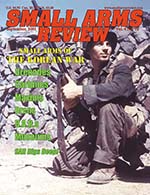Marine Corps Air-Ground Museum in Quantico, VA.
By Dan Szatkowski
U.S. Marine experiences in Korea, the “Forgotten War,” have been comprehensively remembered and preserved in the Marine Corps Air-Ground Museum in Quantico, VA. As a training aid for new Marines, as well as a museum open to the public, the Air-Ground Museum has devoted one third of its buildings to the “police action.” Both serious researchers and casual visitors will find the displays to be no-nonsense and refreshingly lacking in revisionist viewpoint.
The “Korean War” area of the museum is arranged in five major phases of the conflict, from the initial blitzkrieg and rout to the south, the defense of the Pusan perimeter, the remarkable amphibious assault at Inchon, the ill-fated expedition to the Chosin reservoir, and the deadly stalemate demanded by politicians. There is a bitter flavor in the display absent from the more heavily attended and more politically correct museums on the Mall in nearby Washington, D.C. Artifacts in the Air-Ground museum are allowed to tell their own stories and the accompanying photographs clearly show the calculated brutality and viciousness of the communist invaders. All of the artifacts are directly approachable, and the visitor is surrounded by the displays as he passes through the self-guided tour. Special study collections of documents, photographs, and small arms are made available to interested researchers by appointment, but the public display is more than sufficient to impress most visitors.
In 1950, Korea was a state divided by the political machinations of the United Nations, an organization central to the Truman administration’s foreign policy but barely five years old. The Chinese civil war was only two years ended, and Stalin was testing the resolve of the World War II allies all along his “iron curtain.” World War II had only recently brought forty years of Japanese colonialism to an end, and General Douglas MacArthur was establishing himself as nominal king of Japan. Committing the same blunders of intelligence and deployment that assured disaster in the Philippines less than a decade earlier, Americans were surprised by eight divisions of the North Korean People’s Army that struck south without warning on June 25.
The Marines were called to Korea about a week after the well-planned deluge of North Koreans, and the 1st Provisional Marine Brigade came ashore at Pusan on August 2 to reinforce the ill-prepared U.S. and Korean armies that had wilted under the armor, mechanized artillery, and massed infantry of the invaders. Marines brought the best equipment proved in WWII, and the visitor will find examples of the M-1 Garand, The M-1 and M-2 Carbine, the BAR, and Browning heavy and light machine guns. Interestingly absent is the M-3 “grease gun” that officially replaced the Thompson submachine gun, but never won the hearts of the Marines. An F4U-4 (an improved but obsolescent Corsair) and an F9F Panther jet symbolize the aircraft used by Marine fighter squadrons to assist in stabilizing the Pusan perimeter.
Not impressed by American assessments that the terrain was unsuitable for armor, the North Koreans deployed large numbers of T-34 tanks and SU-76 self-propelled guns. Just as the German Wehrmacht had discovered to its dismay, the U.S. military found mere bazookas, mines and grenades ineffective against these well designed weapons deployed along with massed infantry. An SU-76 and an M1942 ZIS 3 field gun are included in the museum displays to emphasize the unexpected well-equipped nature of the invading army.
Much has been written about the remarkable success of MacArthur’s daring amphibious assault at Inchon, an undertaking made possible by the Marine Corps’ expertise and specialized equipment from late WWII. Many serving officers and men had direct experience from places like Saipan and Okinawa. On display are LVT-1 and LVT-3 tracked landing vehicles and an M-26 Pershing tank, machines that made the rapid strike at Inchon and across the Korean peninsula possible. The hardheaded defense of the Pusan perimeter and the shocking success of the Inchon landings led to a rapid collapse of the North Korean logistic support structure. As they fell rapidly back to the north, the communists committed many atrocities, murdered American prisoners of war, and the museum visitor will need a strong stomach to view some of the photographs.
In a doomed advance from the Korean East Coast to the Chosin reservoir, the Marines met a new and enormous army crossing the Yalu River directly from communist China. The story of their orderly withdrawal is a featured lesson in sharp contrast to the collapse of June 1950. The Chinese were stopped near the 38th Parallel, the original dividing line, and held in a stalemate that continues to this day. Several technical advancements that allowed the Americans to hold their own, if not to prevail, are featured at Quantico. Bell and Sikorsky helicopters may cue the MASH television show watchers, but really represent the first true implementation of air-ground force integration. Recoilless rifles allowing organic artillery, all-terrain “Weasel” vehicles, and many other items, including a selection of Chinese mortars, are displayed for close examination.
The Marine Corps Air-Ground Museum is open Tuesday through Saturday, from April 1 to November 15, 10am to 5pm. Located at the Marine Corps Combat Development Command, Quantico, Virginia 22134-5001, and on the USMC webpage, the museum can also be telephoned at (703) 784-2606 weekdays and (703) 784- 2425 on weekends. Two other buildings house exhibits addressing the Marine experience through World War I and World War II, and a standing exhibit detailing the history of the Corps from 1775 can be found at the Washington, D.C. Navy Yard, just forty miles to the north.
This article first appeared in Small Arms Review V4N12 (September 2001) |
| SUBSCRIBER COMMENT AREA |
Comments have not been generated for this article.








